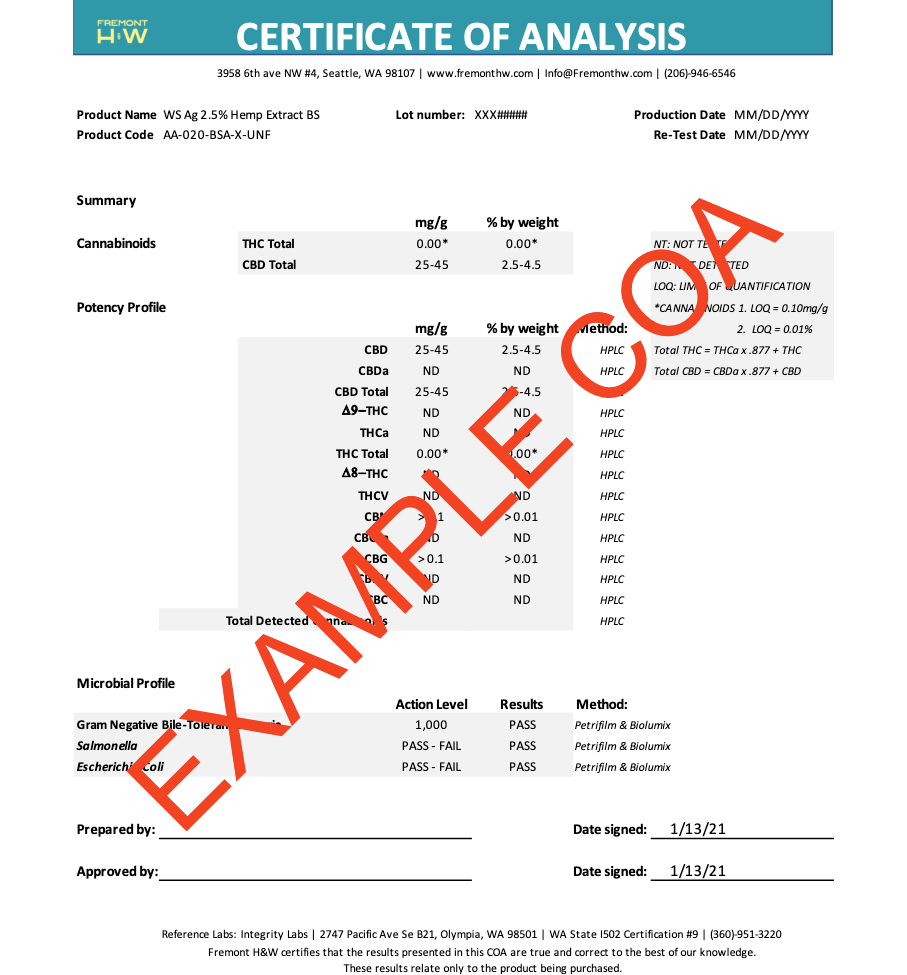A question that many consumers ask about cannabinoid-infused products, including beverages, edibles, and personal care products, is how they can verify that the amount of CBD claimed on the label is actually in the product they purchased. The answer to that question is through the documentation a CBD supplier and CBD brands provide on their products, known in the cannabis industry as a Certification of Analysis – a COA. Ideally, COAs would be an industry standard, but some companies do not make information on batch-level analysis available.
The following is an example of a COA of Broad-Spectrum Hemp product from SōRSE.
It’s important to note that lab tests for cannabis products come in different shapes and sizes. Some contain only cannabinoid content information, while others go much deeper and contain herbicide/pesticide testing, microbial profiles, terpene profiles and much more. Here are some typical components of a COA.
COMPONENTS OF A COA
- Order Confirmation: The product code and lot number validate that the batch that was shipped matches the product ordered.
- Cannabinoids: The data in this section helps a product producer calculate the dosage of the end product.
- Potency Profile: This section lists a number of different cannabinoids with their respective potency levels in the product ordered. This data also confirms whether an order is Broad Spectrum or Isolate. In the COA example, the Potency Profile shows that the product is a Broad Spectrum, as it contains CBD, CBN, CBG or other minor cannabinoids (such as CBC, CBGa, and others) that can present in the distillate. This section also indicates the method for testing; in this case, HPLC refers to High Performance Liquid Chromatography, a method for separating molecules from one another.
- Microbial Profile: This section validates that the product has gone through and passed Microbial Profile testing. Because cannabis is an agricultural product, it is important to test for microbes, yeast/mold, and pathogens such E. Coli and Salmonella to ensure consumer safety.
- Third-Party Testing: All products are tested by a third-party lab to validate in-house results and avoid conflicts of interest.
- Signature Verification: At SōRSE, to ensure the accuracy of the data, each COA is verified by two different team members.
DOCUMENTATION FOR FINISHED GOODS
In terms of infused finished goods, some product producers will share lab results on their products on their websites. Some companies are also utilizing QR codes on their packaging that can be scanned by consumers, linking them to documentation. These documents include the date of analysis, the cannabinoid profile, the method for determining potency, signature verification, and the lab information. Some documentation also included testing for heavy metals, pesticides, and residual solvents.
Sharing and publishing COAs goes a long way for CBD suppliers who want to be seen as prioritizing safety and quality in this growing industry, and for brands seeking to build consumer trust and loyalty. Documentation from both the supplier and product producer verify for the consumer that the product they have purchased is safe, and that they are getting what they paid for. CBD suppliers like SōRSE and brands that share COAs believe in transparency, and that is what a consumer should look for when buying infused products.
If you are looking for a high-quality CBD emulsion powered by a team of experienced food scientists and product developers to get your infused product to market, now is the time to come to the SōRSE. Book a call with our team today!
Let’s Chat
Want to evaluate our emulsions? We’d love to learn more about your business and work to create a custom solution.
Tell us a little about yourself and we’ll be in touch shortly.
Privacy Policy. All rights reserved 2021.

Let’s Chat
Want to evaluate our emulsions? We’d love to learn more about your business and work to create a custom solution.
Tell us a little about yourself and we’ll be in touch shortly.
Privacy Policy. All rights reserved 2021.

Let’s Chat
Want to evaluate our emulsions? We’d love to learn more about your business and work to create a custom solution.
Tell us a little about yourself and we’ll be in touch shortly.
Privacy Policy. All rights reserved 2021.

A
better
emulsion
Here is our step-by-step guide on water-soluble emulsion technology’s impact on stability.


